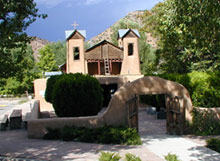Geophagy, or the practice of eating dirt or clay, is practiced by many people around the world. Clay or dirt is used for good luck, anemia, severe tooth abrasions, relief of diarrhea, as an agent to counter toxins and poisons, as an extender, for minerals during pregnancy, to prevent nausea, and for relief of upset stomach, to name a few uses. Many Americans consume clay and other forms of the earth. Have you ever used Kaopectate, Rolaids, Maalox or Mylanta? If so you have consumed ingredients of clay (kaolin).
The earth as a natural and ethnographic resource can be seen in the example of El Santuario de Chimayo. Located in New Mexico, this historic place is also known as the “Lourdes of America” and is an example of how ethnographic resources are given meaning and in turn preserved by community members and visitors. According to the Archdiocese of Santa Fe (2004), two legends surround El Sanctuario de Chimayo, a place of pilgrimage and healing. One tells of Don Bernardo Abieta having a vision while plowing his fields. The vision told him to dig beneath his plow to find earth with great healing powers. He later built the first shrine at this site.
The second legend tells of a friar who, while during daily penance, saw a light burst from a hillside. He went to where the light came from and found a crucifix, the miraculous crucifix of Our Lord of Esquipulas. He took the crucifix to Santa Cruz three times and each time it disappeared and was found in the same hole in which it originated. A small chapel was then erected in this spot and the healing began. The healings came as a result of the miraculous earth or sand found under the shrine. It is said that the earth at Chimayo can be mixed with water to make mud and eaten or applied to the skin in order to heal a person of an ailment. Some people take vials of the sand with them as a remembrance of their pilgrimage to Chimayo.
El Santuario de Chimayo is now on the National Register of Historic Places and is considered to be one of the most beautiful examples of Spanish colonial architecture (NPS 2004). This site has been identified as an ethnographic and cultural resource because it is a place where people go to fulfill a promise, thank God, ask for peace, make a pilgrimage and “feel the healing power of God.” Community members and visitors alike understand the significance of this resource and take measures to preserve the site.


